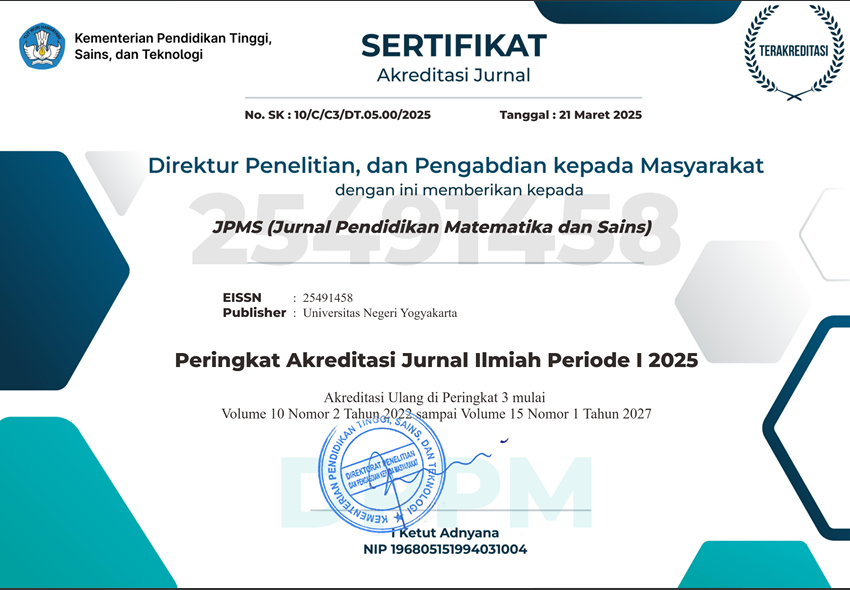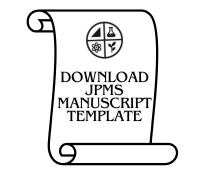Development of a Culturally Contextualized Chemistry Literacy Test Based on West Kalimantan Culture on Thermochemistry Topics
DOI:
https://doi.org/10.21831/jpms.v13i2.84709Keywords:
Chemical literacy, Culturally contextualized, Test instrument, ThermochemistryAbstract
The aim of this research is to produce a chemical literacy assessment instrument based on cultural context for high school students on the topic of thermochemistry. The instrument development was carried out by constructing and validating the culturally contextualized chemical literacy test through the following stages: (1) identification of aspects and indicators of culturally based chemical literacy; (2) construction of the assessment instrument; (3) theoretical validation; (4) empirical validation; (5) reliability testing; and (6) difficulty level analysis. Data were analyzed using the Winsteps application and interpreted through the Rasch Model. The developed instrument consists of 12 items encompassing four chemical literacy indicators: Chemical Knowledge Concept, Chemistry in Context, Higher-Order Thinking Skills, and Attitude. The cultural context includes four West Kalimantan cultural themes: Dayak traditional tuak drinking, betel chewing tradition, nasi hadap-hadapan ceremony, and the karbit cannon festival. Validity was confirmed through Outfit MNSQ, Outfit ZSTD, and Point Measure Correlation (Pt. Mean Corr) values. Reliability analysis showed a Cronbach’s alpha of 0.56 (moderate), person reliability of 0.68 (moderate), and item reliability of 0.95 (very high). The instrument covers various difficulty levels: easy (1 item), moderate (9 items), and difficult (2 items), indicating a well-distributed test construction.
References
Adedoyin, O. O., & Mokobi, T. (2013). Using IRT psychometric analysis in examining the quality of junior certificate mathematics multiple choice examination test items. International Journal of Asian Social Science, 3(4), 992–1011. https://ideas.repec.org/a/asi/ijoass/v3y2013i4p992-1011id2471.html
Alti, R. P., Zulyuri, Z., & Violita, V. (2022). Analysis of the quality of mid-semester examination test items in Biology subject for Class X at MAN 1 Solok Selatan. Jurnal Metaedukasi: Jurnal Ilmiah Pendidikan, 4(2), 70–75. https://jurnal.unsil.ac.id/index.php/metaedukasi/article/view/4089
Anggraini, N., & Yusmaita, E. (2021). Mapping the chemical literacy levels of Class XI MIPA students at SMAN 1 Lubuk Basung on thermochemistry material using the RASCH model. Edukimia, 3(3), 147–154. https://doi.org/10.24036/ekj.v3.i3.a289
Anggreni, U. D., Hadiarti, D., & Fadhilah, R. (2023). Development of acid-base microblogs based on Malay ethnochemistry to preserve culture. Jurnal Penelitian Pendidikan IPA, 9(8), 6067–6075. https://doi.org/10.29303/jppipa.v9i8.4300
Arikunto. (2010). Research procedures: A practical approach. Rineka Cipta.
Asyhari, A. (2019). Development of Islamic values and Indonesian culture-based science literacy assessment instruments using a contextual approach. Lentera Pendidikan: Jurnal Ilmu Tarbiyah dan Keguruan, 22(1), 166–179. https://journal.uin-alauddin.ac.id/index.php/lentera_pendidikan/article/view/6437
Asyhari, A., & Asyhari, A. (2017). Science literacy based on Islamic values and Indonesian culture. Jurnal Ilmiah Pendidikan Fisika Al-Biruni, 6(1), 137–148. https://ejournal.radenintan.ac.id/index.php/al-biruni/article/view/1584
Atmojo, S. E., Kurniawati, W., & Muhtarom, T. (2019). Science learning integrated with ethnoscience to enhance scientific literacy and character. In Journal of Physics: Conference Series (Vol. 1254, No. 1, p. 012033). IOP Publishing. DOI:10.1088/1742-6596/1254/1/012033
Bano, V. O., Marambaawang, D. N., & Njoeroemana, Y. (2022). Analysis of criteria for school examination test items in science subjects at SMP Negeri 1 Waingapu. Ideas: Jurnal Pendidikan, Sosial, dan Budaya, 8(1), 145–152. https://jurnal.ideaspublishing.co.id/index.php/ideas/article/view/660
Boone, W. J., Staver, J. R., & Yale, M. S. (2017). Rasch analysis in the human sciences. Springer Science & Business Media. https://doi.org/10.1007/978-94-007-6857-4
Cigdemoglu, C., Arslan, H. O., & Cam, A. (2017). Argumentation to foster pre-service science teachers' knowledge, competency, and attitude on the domains of chemical literacy of acids and bases. Chemistry Education Research and Practice, 18(2), 288–303. https://doi.org/10.1039/C6RP00167J
Dalgety, J., Coll, R. K., & Jones, A. (2003). Development of chemistry attitudes and experiences questionnaire (CAEQ). Journal of Research in Science Teaching, 40(7), 649-668. https://doi.org/10.1002/tea.10103
Dewi, C. A., Khery, Y., & Erna, M. (2019). An ethnoscience study in chemistry learning to develop scientific literacy. Jurnal Pendidikan IPA Indonesia, 8(2), 279–287. https://doi.org/10.15294/jpii.v8i2.19261
Fuadi, H., Robbia, A. Z., Jamaluddin, J., & Jufri, A. W. (2020). Analysis of factors causing low scientific literacy ability among students. Jurnal Ilmiah Profesi Pendidikan, 5(2), 108–116. DOI: 10.29303/jipp.v5i2.122
Ihsan, M. S., & Jannah, S. W. (2021). Analysis of students' scientific literacy ability in chemistry learning using blended learning-based interactive multimedia. EduMatSains: Jurnal Pendidikan, Matematika dan Sains, 6(1), 197–206. https://doi.org/10.33541/edumatsains.v6i1.2934
Ke, L., Sadler, T. D., Zangori, L., & Friedrichsen, P. J. (2021). Developing and using multiple models to promote scientific literacy in the context of socio-scientific issues. Science & Education, 30(3), 589–607. https://doi.org/10.1007/s11191-021-00206-1
Kristanto, T. K., Prasetya, A. T., & Sumarni, W. (2024). Reconstruction of indigenous science into scientific knowledge of making Chinese New Year cakes as chemistry literacy teaching materials. Jurnal Pendidikan Kimia Undiksha, 8(1). https://doi.org/10.23887/jjpk.v8i1.76385
Kundera, I. N. (2021). The effect of contextual collaborative learning based on ethnoscience to increase students' scientific literacy ability. Journal of Turkish Science Education, 18(3), 525–541. https://doi.org/10.36681/tused.2021.88
Lestari, D. D., & Muchlis, M. (2021). Contextual teaching and learning-oriented E-LKPD to train students' critical thinking skills on thermochemistry material. Jurnal Pendidikan Kimia Indonesia, 5(1), 25–33. https://doi.org/10.23887/jpk.v5i1.30987
Mellyzar, M., Lukman, I. R., & Busyraturrahmi, B. (2022). The effect of Process Oriented Guided Inquiry Learning (POGIL) strategy on scientific process skills and chemical literacy ability. Jambura Journal of Educational Chemistry, 4(2), 70–76. https://doi.org/10.34312/jjec.v4i2.15338
Nada, E. I., & Sari, W. K. (2021). Analysis of UoS contextual chemical literacy ability of chemistry pre-service teachers on reaction rate topic. In Journal of Physics: Conference Series (Vol. 1796, No. 1, p. 012114). IOP Publishing. https://doi.org/10.1088/1742-6596/1796/1/012114
Rubini, B., Ardianto, D., Setyaningsih, S., & Sariningrum, A. (2019, June). Using socio-scientific issues in problem-based learning to enhance science literacy. In Journal of Physics: Conference Series (Vol. 1233, No. 1, p. 012073). IOP Publishing. https://doi.org/10.1088/1742-6596/1233/1/012073
Rusmansyah, R., Leny, L., & Sofia, H. N. (2023). Improving students' scientific literacy and cognitive learning outcomes through ethnoscience-based project-based learning (PjBL) model. Journal of
Innovation in Educational and Cultural Research, 4(1), 1–9. https://doi.org/10.46843/jiecr.v4i1.382
Sanova, A., Afrida, A., Bakar, A., & Yuniarccih, H. R. (2021). Ethnoscience approach through problem-based learning model towards chemical literacy ability on buffer solution material. Jurnal Zarah, 9(2), 105–110. https://doi.org/10.31629/zarah.v9i2.3814
Setyorini, A. D., Yamtinah, S., Mahardiani, L., & Saputro, S. (2021). A Rasch analysis of item quality of the chemical literacy assessment for investigating students' chemical literacy on chemical rate concepts. European Journal of Educational Research, 10(4), 1769–1779. https://doi.org/10.12973/eu-jer.10.4.1769
Shwartz, Y., Ben-Zvi, R., & Hofstein, A. (2006). The use of scientific literacy taxonomy for assessing the development of chemical literacy among high-school students. Chemistry Education Research and Practice, 7(4), 203–225. https://doi.org/10.1039/B6RP90011A
Sjí¶strí¶m, J., Yavuzkaya, M., Guerrero, G., & Eilks, I. (2024). Critical chemical literacy as a main goal of chemistry education aiming for climate empowerment and agency. Journal of Chemical Education, 101(10), 4189–4195. https://doi.org/10.1021/acs.jchemed.4c00452
Sumintono, B., & Widhiarso, W. (2015). Educational assessment and examination: Application of Rasch modelling in educational assessment. Trim Komunikata.
Sumirah, S., Arsyad, M., & Sukarno, S. (2023). The role of Islamic education teachers in developing students' scientific attitudes and literacy. Journal of Educational Research, 2(1), 81–98. https://doi.org/10.56436/jer.v2i1.215
Trochim, W.M. (1999). The research methods knowledge base (2nd Ed.). Cincinnati, OH: Atomic Dog.
Wibowo, T., & Ariyatun, A. (2020). The science literacy ability of high school students through ethnoscience-based chemistry learning. Edusains, 12(2), 214–222. https://doi.org/10.15408/es.v12i2.16382
Wiyarsi, A., Pratomo, H., & Priyambodo, E. (2020). Chemical literacy of vocational high school students in context-based learning: A case study on the petroleum topic. Journal of Turkish Science Education, 17(1), 147–161. https://doi.org/10.1088/1742-6596/1397/1/012036
Wiyarsi, A., Prodjosantoso, A. K., & Nugraheni, A. R. (2021). Enhancing students' scientific habits of mind and chemical literacy through socio-scientific issues within inquiry-based learning. Frontiers in Education, 6, 660495. https://doi.org/10.3389/feduc.2021.660495
Yusmar, F., & Fadilah, R. E. (2023). An analysis of Indonesian students' low science literacy: PISA results and contributing factors. LENSA (Lentera Sains): Journal of Science Education, 13(1), 11–19. https://doi.org/10.24929/lensa.v13i1.283
Yustin, D. L., & Wiyarsi, A. (2019, December). Students' chemical literacy: A study on chemical bonding. Journal of Physics: Conference Series, 1397(1), 012036. https://doi.org/10.1088/1742-6596/1397/1/012036
Downloads
Published
How to Cite
Issue
Section
Citation Check
License
Copyright (c) 2025 Jurnal Pendidikan Matematika dan Sains

This work is licensed under a Creative Commons Attribution-ShareAlike 4.0 International License.
Jurnal Pendidikan Matematika dan Sains allows readers to read, download, copy, distribute, print, search, or link to its articles' full texts and allows readers to use them for any other lawful purpose. The journal allows the author(s) to hold the copyright without restrictions. Finally, the journal allows the author(s) to retain publishing rights without restrictions
- Authors are allowed to archive their submitted article in an open access repository
- Authors are allowed to archive the final published article in an open access repository with an acknowledgment of its initial publication in this journal

This work is licensed under a Creative Commons Attribution-ShareAlike 4.0 Generic License.





